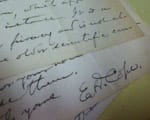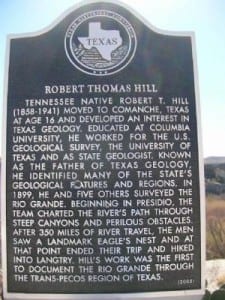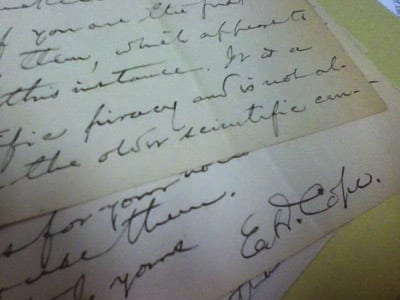Texas author, journalist and historian Clay Coppedge, who writes for the weekly newspaper Country World News, covered the research of SMU vertebrate paleontologist Louis L. Jacobs and the infamous Bone Wars of the late 1800s.
See an SMU video and press release about the research, “Texas frontier scientists who uncovered state’s fossil history had role in epic Bone Wars.”
The Bone Wars was a flurry of fossil speculation across the American West that escalated into a high-profile national feud. Drawn into the spectacle were two scientists from the Lone Star State, geologist Robert T. Hill, now acclaimed as the Father of Texas Geology, and naturalist Jacob Boll, who made many of the state’s earliest fossil discoveries.
The Coppedge article, “Bone Wars,” was published in a November issue of Country World News, and was published in December online at TexasEscapes.com.
Hill and Boll had supporting roles in the Bone Wars through their work for one of the feud’s antagonists, Edward Drinker Cope, according to Jacobs’ new study.
A professor in Dedman College‘s Roy M. Huffington Department of Earth Sciences, Jacobs joined SMU’s faculty in 1983.
Currently his field projects include work in Mongolia and Angola. His book, “Lone Star Dinosaurs” (1999, Texas A&M University Press) was the basis of an exhibit at the Fort Worth Museum of Science and History that traveled the state. He consulted on the new exhibit, Mysteries of the Texas Dinosaurs, which opened in 2009.
EXCERPT:
By Clay Coppedge
Texas Escapes
It’s been pointed out that there were two great revolutions in American life in the 19th Century. One was the Civil War. The other was a scientific revolution. Just as the firing on Fort Sumter was the shot that got the Civil War going, Charles Darwin’s theory of evolution, published in “Origin of Species” in 1859 created a similar upheaval in the scientific world.At the same time, scientists, naturalists and other observant types were finding the bones of creatures that roamed the earth millions of years ago that were unlike anything the world had seen or imagined. Some of these creatures were truly gargantuan with neck bones alone measuring three feet across. Even the land where people lived had changed dramatically over the eons; in some cases it hadn’t even been land at all – it was a sea. This was a hard thing for people of the time to grasp.
Europeans never had much luck finding dinosaur bones. Too lush. Too wet. The American West was neither of those things. Striding into that vast and arid land, two scientists led the search for dinosaur bones and new species to name. Their respective and separate searches developed into an intense rivalry between the two bone hunters – Edward Drinker Cope of the Academy of Natural Sciences in Philadelphia and Othenial Charles Marsh with the Peabody Museum of Natural History at Yale.
Follow SMU Research on Twitter, @smuresearch.
For more SMU research see www.smuresearch.com.
SMU is a nationally ranked private university in Dallas founded 100 years ago. Today, SMU enrolls nearly 11,000 students who benefit from the academic opportunities and international reach of seven degree-granting schools. For more information, www.smu.edu.
SMU has an uplink facility located on campus for live TV, radio, or online interviews. To speak with an SMU expert or book an SMU guest in the studio, call SMU News & Communications at 214-768-7650.




 SMU contributes fossils, expertise to new Perot Museum in ongoing scientific collaboration
SMU contributes fossils, expertise to new Perot Museum in ongoing scientific collaboration 100 million-year-old coelacanth discovered in Texas is new fish species from Cretaceous
100 million-year-old coelacanth discovered in Texas is new fish species from Cretaceous Observed! SMU’s LHC physicists confirm new particle; Higgs ‘God particle’ opens new frontier of exploration
Observed! SMU’s LHC physicists confirm new particle; Higgs ‘God particle’ opens new frontier of exploration DOE Award: advancing SMU’s link to the God particle
DOE Award: advancing SMU’s link to the God particle